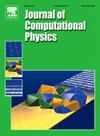A multi-mesh approach for accurate computation of multi-target functionals in aerodynamics design
IF 3.8
2区 物理与天体物理
Q2 COMPUTER SCIENCE, INTERDISCIPLINARY APPLICATIONS
引用次数: 0
Abstract
Aerodynamic optimal design is crucial for enhancing performance of aircrafts, while calculating multi-target functionals through solving dual equations with arbitrary right-hand sides remains challenging. In this paper, a novel multi-target framework of DWR-based mesh refinement is proposed and analyzed. Theoretically, an extrapolation method is generalized to expand multi-variable functionals, which guarantees that the dual equations of different objective functionals can be calculated separately. Numerically, an algorithm of calculating multi-target functionals is designed based on the multi-mesh approach, which can help to obtain different dual solutions simultaneously. One feature of our framework is that the algorithm is easy to implement with the help of the hierarchical geometry tree structure and the calculation avoids the Galerkin orthogonality naturally. The framework takes a balance between different targets even when they are not the same orders of magnitude. While existing approach uses a linear combination of different components in multi-target functionals for adaptation, it introduces additional coefficients for adjusting. With each component calculated under a dual-consistent scheme, this multi-mesh framework addresses challenges such as the lift-drag ratio and other kinds of multi-target functionals, ensuring smooth convergence and precise calculations of dual solutions.
空气动力学设计中多目标泛函精确计算的多网格方法
气动优化设计是提高飞机性能的关键,而通过求解任意右侧的对偶方程来计算多目标泛函仍然是一个挑战。本文提出并分析了一种新的基于dwr的多目标网格细化框架。理论上,将外推法推广到多变量泛函的展开中,保证了不同目标泛函的对偶方程可以单独计算。数值上,设计了一种基于多网格法的多目标泛函计算算法,可同时获得不同的对偶解。该框架的一个特点是借助于分层几何树形结构,算法易于实现,且计算自然避免了伽辽金正交性。该框架在不同的目标之间取得平衡,即使它们的数量级不同。现有方法采用多目标函数中不同分量的线性组合进行自适应,同时引入了额外的调整系数。由于每个分量都在双重一致性方案下计算,这种多网格框架解决了升阻比和其他多目标函数等挑战,确保了对偶解的平滑收敛和精确计算。
本文章由计算机程序翻译,如有差异,请以英文原文为准。
求助全文
约1分钟内获得全文
求助全文
来源期刊

Journal of Computational Physics
物理-计算机:跨学科应用
CiteScore
7.60
自引率
14.60%
发文量
763
审稿时长
5.8 months
期刊介绍:
Journal of Computational Physics thoroughly treats the computational aspects of physical problems, presenting techniques for the numerical solution of mathematical equations arising in all areas of physics. The journal seeks to emphasize methods that cross disciplinary boundaries.
The Journal of Computational Physics also publishes short notes of 4 pages or less (including figures, tables, and references but excluding title pages). Letters to the Editor commenting on articles already published in this Journal will also be considered. Neither notes nor letters should have an abstract.
 求助内容:
求助内容: 应助结果提醒方式:
应助结果提醒方式:


